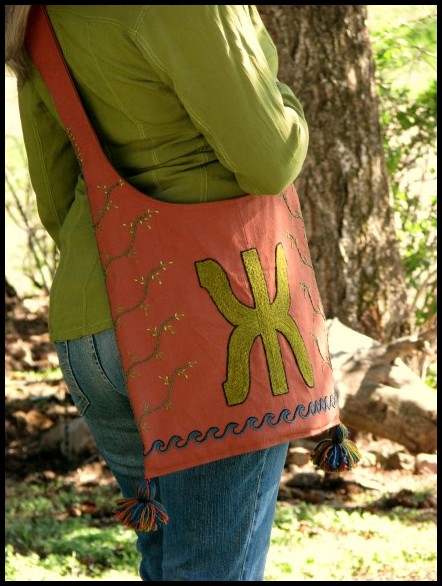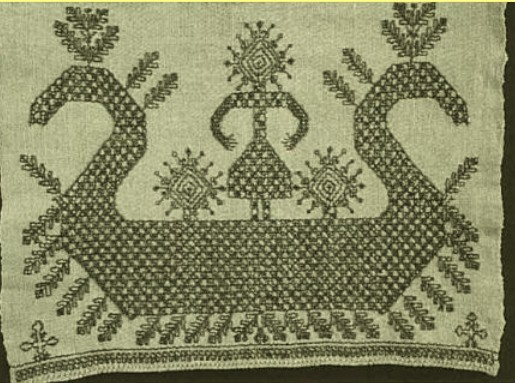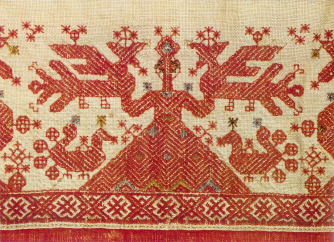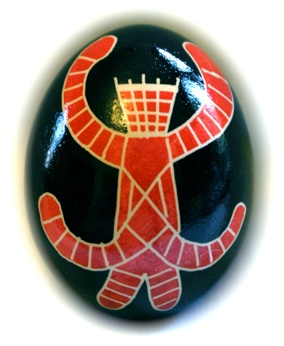

Zhena Zhe Berehynia Bag
![]()

Available for purchase at Etsy
This Zhena Berehynia Embroidered Bag is rust cotton canvas that is fully lined. The length measures 33" from the corner of the bag to the top of the strap. The bag portion measures 13 inches high by 16 wide.
Berehynja (Berehynia, Bereginia, Bereginy) is the Slavic Mother of protection. In the ancient Slavic bereh means river bank, showing the water origins of the Mother. In textiles she was anciently depicted on a double-headed boat on the water, but on folk wood working she was represented as a fish tailed mermaid. In the springtime she was portrayed with plants, sprouting vines and birds. Later the berehynja, always viewed as beneficial, was replaced by the malevolently viewed rusalka (rusalki - pl.). The rusalki were said to be mermaids, water nymph demons. On her feast days the women of the villages would gather at the river banks with their distaffs (prialki) and spindles so that Berehynja could spin. The Rusalki are also known for being spinners, and spinners of fate.


Ukranian women have used her symbols for centuries in pysanky (egg-decorating) and rushnyky (embroidery of ritual cloth). Her form, a woman with her arms raised, has been modified through the centuries, but has remained a symbol of protection. Her images also occur on the wood carved prialki. The symbol that became the Cyrillic letter Ze, is a figure of a women with the upraised arms. The Slavic word for woman, zhena, begins with this letter .

In many ancient matrilineal cultures, this symbol keeps appearing, from Old
South Europe, through the Aegean Sea territories, Western Anatolia, the ancient
Middle East and into Northern Africa. This symbol dates back as far as 5500
BCE. In a number of these cultures, the Zhe symbol came to be used in a pictographic
writing system that preceded the syllabic alphabets. In the ancient Phoenician
the letter is now called zayin (Z), mistakenly associated with weapons by
the later patriarchal Hebrews. In the Perso-Arabic the letter is called Ze.
The Galgolitic language called it a zhivete and it represented “to live”.
In the Proto-Slavic the letter is Zhe and represented a woman, which began
the Slavic word zhena/woman. The nomadic Imazighen (Berber), who claim decent
from the ancient Phoenicians call the letter Zhe as well. There are many ancient
cultures that passed this symbol on to later alphabets, whether with curved
arms and legs, or straight.

There is a common pattern between the symbols that became letter Z and the feminine association in the ancient, even to the modern work of artisans from ancient figurines with upraised arms, to inscriptions and pysanky eggs. While patriarchal Indo-European cultures sought to remove the pictographic application of the symbols when they created syllabic alphabets from the pictographic writings of each peoples they conquered, especially those associated with women, they cannot rewrite the history that is being uncovered by archaeologists that speak of the ancient women, the women with their arms upraised, the life givers and life rejoicers.